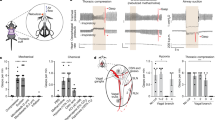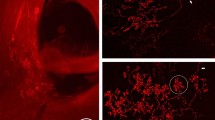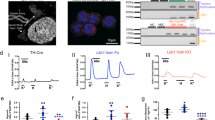Abstract
PULMONARY neuroepithelial bodies, composed of innervated clus-ters of amine- and peptide-containing cells, are widely distributed throughout the airway mucosa of human and animal lungs1–3. Structurally, neuroepithelial bodies resemble chemoreceptors (such as carotid body, taste buds) and are thought to function as hypoxia-sensitive airway sensors4. Evidence for this is indirect, however, and the mechanism of oxygen sensing by these cells is unknown. Here we culture neuroepithelial bodies isolated from rabbit fetal lungs and identify voltage-activated potassium, calcium and sodium currents using the whole-cell patch clamp technique. Upon exposure to hypoxia there is a reversible reduction (25–30%) in the outward potassium current, with no change in inward currents. In addition, we demonstrate the expression of an oxygen-binding protein (b-cytochrome, NADPH oxidase) on the plasma membrane of these cells. The identification of an oxygen-sensing mechanism (namely the presence of an O2-sensitive potassium channel coupled to an O2 sensor protein5) in the cells of pulmonary neuroepithelial bodies indicates that they are transducers of the hypoxia stimulus and hence may function as airway chemoreceptors in the regulation of respiration.
This is a preview of subscription content, access via your institution
Access options
Subscribe to this journal
Receive 51 print issues and online access
$199.00 per year
only $3.90 per issue
Buy this article
- Purchase on Springer Link
- Instant access to full article PDF
Prices may be subject to local taxes which are calculated during checkout
Similar content being viewed by others
References
Lauweryns, J. M. & Cokelaere, M. Z. Zellforsch. 145, 521–540 (1973).
Cutz, E., Gillan, J. & Track, N. in The Endocrine Lung in Health and Disease (eds Becker, K. L. & Gazdar, A. F.) 210–231 (Saunders, Philadelphia, 1984).
Lauweryns, J. M. & VanLommel, A. Expl Lung Res. 11, 319–339 (1986).
Lauweryns, J. M. et al. Cell Tiss. Res. 182, 425–440 (1977).
Gonzalez, C., Almaraz, L., Obeso, A. & Rigual, R. Trends Neurosci. 15, 146–153 (1992).
Cutz, E. et al. Lab. Invest. 53, 672–683 (1985).
Stuart, A. E., Hudspeth, A. J. & Hall, Z. W. Cell Tiss. Res. 153, 55–61 (1974).
Hamill, O. P., Marty, A., Neher, E., Sackmann, B. & Sigworth, F. Pflugers Arch. 391, 85–100 (1981).
Acker, H., Dufau, E., Huber, J. & Sylvester, D. FEBS Lett. 256, 75–78 (1989).
Jesaitis, A. J. et al. J. clin. Invest. 85, 821–835 (1990).
Parkos, C. A., Allen, R. A., Cochrane, C. G. & Jesaitis, A. J. J. clin. Invest. 80, 732–742 (1987).
Cross, A. R. et al. Biochem. J. 272, 743–747 (1990).
Lopez-Barneo, J., Lopez-Lopez, J. R., Urena, J. & Gonzalez, C. Science 241, 580–582 (1988).
Stea, A. & Nurse, C. A. Pflugers Arch. 418, 93–101 (1991).
Lopez-Lopez, J., Gonzalez, C., Urena, J. & Lopez-Barneo, J. J. gen. Physiol. 93, 1001–1015 (1989).
Stea, A. & Nurse, C. A. Neuroscience 47, 727–736 (1992).
Ganfornina, M. D. & Lopez-Barneo, J. Proc. natn. Acad. Sci. U.S.A. 88, 2927–2930 (1991).
Cutz, E. et al. in Arterial Chemoreception (eds Eyzaguirre, C., Fidone, S. J., Fitzgerald, R. S., Lahiri, S. & McDonald, D. M.) 432–437 (Springer, New York, 1990).
Cho, T., Chan, W. & Cutz, E. Cell Tiss. Res. 255, 353–362 (1989).
Hertzberg, T., Hellstrom, S., Lagercratz, H. & Pequignot, J. M. J. Physiol. 425, 211–225 (1990).
Perrin, D. G., McDonald, T. J. & Cutz, E. Ped. Path. 11, 431–447 (1991).
Gazdar, A. F. et al. Cancer Res. 48, 4078–4082 (1988).
Moody, T. W., Pert, C. B., Gazdar, A. F., Carney, D. N. & Minna, J. D. Science 214, 1246–1248 (1981).
Schuller, H. M. Expl Lung Res. 17, 837–852 (1991).
Polak, J. M. et al. Anat. Rec. 236, 169–171 (1993).
Zaccone, G. et al. Acta zoologica 73, 177–183 (1992).
Sternberger, L. A. Immunocytochemistry 104–109 (Wiley, New York, 1979).
Author information
Authors and Affiliations
Rights and permissions
About this article
Cite this article
Youngson, C., Nurse, C., Yeger, H. et al. Oxygen sensing in airway chemoreceptors. Nature 365, 153–155 (1993). https://doi.org/10.1038/365153a0
Received:
Accepted:
Issue Date:
DOI: https://doi.org/10.1038/365153a0
This article is cited by
-
A vagal reflex evoked by airway closure
Nature (2024)
-
Single-cell transcriptomic analysis of neuroepithelial cells and other cell types of the gills of zebrafish (Danio rerio) exposed to hypoxia
Scientific Reports (2022)
-
Identification of oxygen-sensitive neuroepithelial cells through an endogenous reporter gene in larval and adult transgenic zebrafish
Cell and Tissue Research (2021)
-
Selective gene expression analysis of the neuroepithelial body microenvironment in postnatal lungs with special interest for potential stem cell characteristics
Respiratory Research (2017)
-
A mitochondrial redox oxygen sensor in the pulmonary vasculature and ductus arteriosus
Pflügers Archiv - European Journal of Physiology (2016)
Comments
By submitting a comment you agree to abide by our Terms and Community Guidelines. If you find something abusive or that does not comply with our terms or guidelines please flag it as inappropriate.



